Growing Up in Scotland: patterns of maternal employment and barriers to paid work
This report uses data from the Growing Up in Scotland study to investigate the employment patterns of mothers during the first 5 years of their child's life.
3 Employment And Work-Seeking Status And Characteristics Of Mothers Seeking Work
3.1 Introduction
This chapter examines, first of all, the proportion of mothers in each of the two birth cohorts who were in paid work; not in paid work and looking for work, or not in paid work and not looking for work when the cohort child was aged 10 months, 3 years and 5 years old. It then moves on to explore differences between mothers who were seeking work and other mothers. It does so through examining the characteristics of mothers who were seeking work and illustrating the extent to which these mothers were different to those who were either in paid work or were not in paid work but not looking for work. For the latter parts of the chapter, analysis is restricted to data from BC2. The characteristics used describe a wide range of demographic, socio-economic and family circumstances including household income, mother’s highest level of education, child and maternal health, family type and number of children in the household.
3.2 Key findings
- Mothers of children in BC2 were more likely to be in paid work than mothers of children in BC1. For example, when the child was aged 10 months, 62% of mothers in BC2 were in work compared with 58% of mothers in BC1.
- In both cohorts, the proportion of mothers who were in paid work increased as the cohort children grew older. In BC2, the proportion of mothers who were in work increased from 62% when the child was aged 10 months to 70% when the child was aged 5.
- Mothers who were looking for work tended to be younger than those who were in paid work or not in paid work and not looking for work. This difference was evident at all age points.
- Mothers looking for work also had lower educational qualifications than other mothers (including those who were in work). But among mothers who were not in paid work, those looking and not looking for work had similar levels of education.
- Mothers seeking work were considerably more likely to be in lower income households than other mothers. Even among mothers who were not in paid work, those seeking work tended to be from lower income households. For example, when the cohort child was aged 3 only 3% of mothers who were seeking work were in the highest income group compared with 21% of mothers who were out of work but not seeking work. Differences were similar at age 5.
- Mothers who were looking for work were more likely than other mothers to be single parents and less likely to be living in couples.
- Compared with mothers who were not in paid employment but not looking for work, those who were looking for work had fewer children, at all age points. Their children also tended to be older. At the time the cohort child was aged 5, 27% of mothers looking for work had a child aged younger than 3 compared with 40% of other mothers.
- When the child was aged 3, 15% of mothers who were looking for work reported a long-term health condition compared with 24% of those who were out of work and not looking. Differences when the child was aged 10 months and 5 years showed a similar pattern, but were not statistically significant.
- After controlling for other factors, younger maternal age (aged under 30 – and particularly aged under 20 – when the child was born) and lower household income were the two strongest and most consistent predictors of work-seeking across each of the age points.
3.3 Change in employment status between the cohorts
Mothers of children in BC2 were more likely to be in paid work than mothers of children in BC1 (Table 3‑1). There was a four to five percentage point difference at each age point. For example, when the child was aged 10 months, 62% of mothers in BC2 were in work compared with 58% of mothers in BC1.
Mothers of children in BC1 were more likely to be out of work and not looking for work than mothers in BC2 [12] . Again, this difference was evident at each age point – although the comparison is not fully possible at age 10 months. When the child was aged 3, 32% of mothers in BC1 were out of work and not looking for work compared with 29% of mothers in BC2.
There were no differences in the proportion of mothers who were looking for work between the cohorts at any age point.
3.4 Changes in employment status according to the child’s age
In both cohorts, the proportion of mothers who were in paid work increased as the cohort child grew older. For example, in BC2, the proportion of mothers who were in work increased from 62% when the child was aged 10 months to 70% when the child was 5 years old. The comparable figure in BC1 increased by a similar amount of around seven percentage points from 58% to 65%.
The corresponding decrease occurred in the proportion of mothers who were not in paid work and not looking for work. For BC2, this dropped from 32% when the child was aged 10 months to 25% when the child was aged 5.
In both cohorts, there was no notable difference in the proportion of mothers who were looking for work at each age point.
Table 3‑1: Employment and work-seeking status, by cohort and by child age
| In paid work |
Not in paid work – looking for work |
Not in paid work – not looking for work |
Not in paid work – unclear whether seeking work |
Unweighted bases |
||
|---|---|---|---|---|---|---|
| 10 months |
||||||
| BC1 |
% |
58 |
4 |
29 |
9 |
5147 |
| BC2 |
% |
62 |
6 |
32 |
N/A |
6003 |
| Age 3 |
||||||
| BC1 |
% |
62 |
6 |
32 |
N/A |
4190 |
| BC2 |
% |
66 |
6 |
29 |
N/A |
4873 |
| Age 5 |
||||||
| BC1 |
% |
65 |
6 |
29 |
N/A |
3829 |
| BC2 |
% |
70 |
5 |
25 |
N/A |
4282 |
Bases: All mothers
3.5 Characteristics of mothers looking for work
This section explores characteristics of mothers in BC2 who were out of work and looking for work.
3.5.1 Age, education, income and social class
Compared with all other mothers – i.e. those who were either in paid work, or not in paid work and not seeking work – mothers who were looking for work tended to be younger. When the child was aged 10 months, 18% of those seeking work were under 20 when the cohort child was born compared with 6% of other mothers (Figure 3-1). In contrast, 49% of other mothers were aged 30 or older when their child was born compared with 24% of those looking for work. This difference persisted when the child was aged 3 and 5. At each age point, mothers who were looking for work were notably younger than other mothers.
When comparing more specifically with mothers who were not in paid work and not seeking work, those who were looking for work still tended to be younger, though the difference was less stark than when compared to all other mothers. For example, when the child was 10 months old, 13% of mothers who were not in paid work and not seeking work were aged under 20 at the child’s birth and 36% were aged 30 or older compared with 18% and 24% of those seeking work as noted above.
Figure 3‑1: Maternal age at child’s birth, by mother’s employment and work-seeking status when child aged 10 months
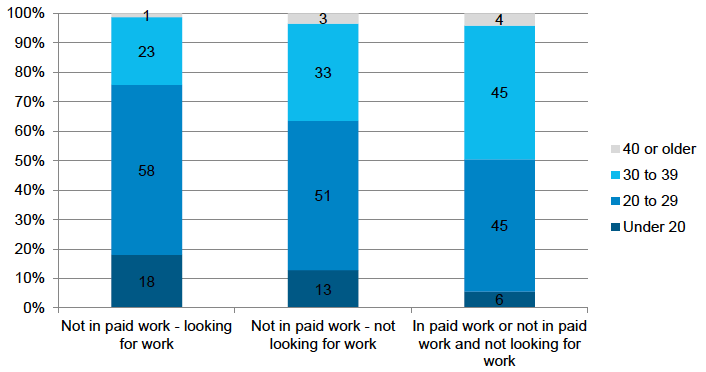
Base: All mothers. Base sizes (unweighted/weighted): Not in paid work - looking for work=315/338; Not in paid work - not looking for work=1748/1831; In paid work or not in paid work and not looking for work=5675/5647.
Differences in the age of mothers who were not in paid work according to their job seeking status increased as the child grew older. By age 5, 22% of mothers seeking work were aged under 20 at the child’s birth compared with 8% of those out of work but not looking for work. This difference of 14 percentage points increased from a difference of 5 percentage points at age 10 months.
Mothers who were looking for work had lower educational qualifications than other mothers. When the child was aged 10 months, 26% of mothers looking for work had a highest qualification at or below lower standard grade level compared with 15% of other mothers (Figure 3-2). Only 14% of mothers seeking employment when the child was aged 10 months had a degree-level qualification compared with 34% of other mothers. These differences were similar when the child was aged 3 and 5.
Figure 3‑2: Mother’s highest educational qualification, by mother’s employment and work-seeking status when child aged 10 months
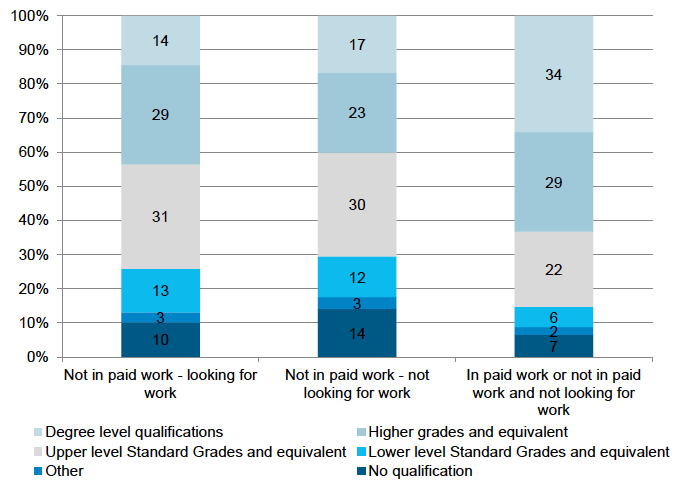
Base: All mothers. Base sizes (unweighted/weighted): Not in paid work - looking for work=315/338; Not in paid work - not looking for work=1746/1829; In paid work or not in paid work and not looking for work=5671/5644.
There were no statistically significant differences in the highest qualification levels held by mothers who were not in paid work according to their work-seeking status, at any age point.
As may be expected, mothers who were looking for work were considerably more likely than other mothers to be in lower income households at all age points. For example, when the child was aged 3, 66% of mothers who were looking for work were in the lowest income group compared with 25% of those who were in paid work or were not in paid work but not seeking work (Figure 3-3).
Figure 3‑3: Equivalised annual household income (quintiles), by mother’s employment and work-seeking status when child aged 3
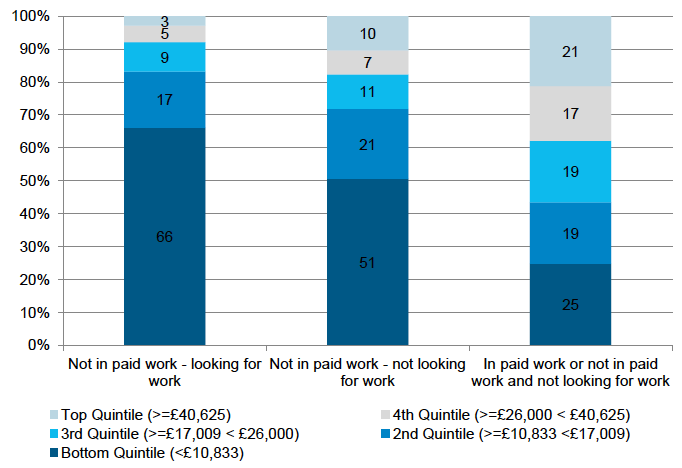
Base: All mothers. Base sizes (unweighted/weighted): Not in paid work - looking for work=179/227; Not in paid work - not looking for work=997/1104; In paid work or not in paid work and not looking for work=4072/3975.
Looking solely at mothers who were not in paid work, at the time the child was 10 months, in terms of income those who were seeking work did not differ significantly from those who were not. However, by age 3 a stark difference had emerged, with those seeking work considerably more likely to be in lower income households than those not seeking work. Only 3% of mothers seeking work were in the highest income group compared with 21% of mothers who were out of work but not seeking work. The differences were similar at age 5.
Compared with other mothers (including mothers in paid work), those who were looking for work tended to have lower socio-economic classifications. When the child was 10 months, 50% of mothers looking for work had held routine or semi-routine occupations compared with 30% of other mothers. In contrast, 37% of other mothers were classed as managerial/professional compared with 17% of those seeking work. The differences between the two groups were similar at ages 3 and 5.
Interestingly, the proportion of mothers looking for work who were classed in the routine/semi-routine category increased as the child grew older, whereas the proportion classed in the managerial/professional decreased. When the child was aged 10 months, 50% of mothers looking for work were classed in routine/semi-routine and 17% in managerial/professional. When the child was aged 5, these figures had changed to 61% and 9% respectively.
When the child was aged 10 months, among mothers who were not in paid work, the only notable difference in the socio-economic classifications between those who were and were not looking for work was the proportion who had never worked: 19% of those not looking for work had never worked compared with 10% of those looking for work. There were no statistically significant differences in the socio-economic classification of mothers looking and not looking for work when the child was aged 3. By age 5, however, mothers seeking work were more likely than those not in paid work but not looking for work to be in the routine/semi-routine category (61% compared with 46%), and less likely to be in the managerial/professional category (9% compared with 17%).
3.5.2 Family characteristics
Mothers who were seeking work were more likely than other mothers to be single parents and less likely to be living in couples. When the child was aged 10 months, 39% of mothers who were looking for work were living as single parents compared with 20% of other mothers. The proportion of those looking for work who were single parents increased as the child grew older. When the child was aged 3, 50% of mothers looking for work were single parents – compared with 20% of other mothers – rising to 54% at age 5, compared with 19% of other mothers (Figure 3-4).
Figure 3‑4: Family type, by mother’s employment and work-seeking status when child aged 5
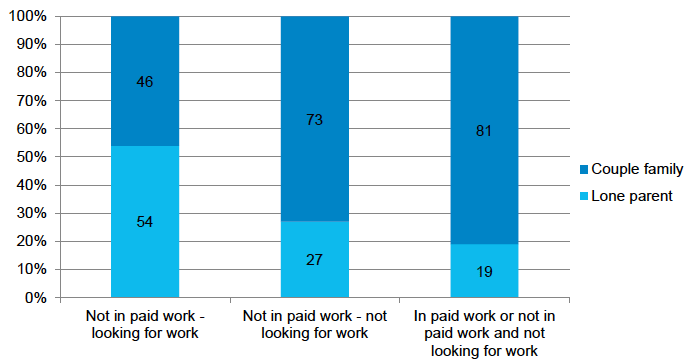
Base: All mothers. Base sizes (unweighted/weighted): Not in paid work - looking for work=173/232; Not in paid work - not looking for work=917/1067; In paid work or not in paid work and not looking for work=4109/4041.
Initially, looking only at mothers who were not in paid work, those who were and were not looking for work were very similar in terms of single parent status. When the child was 10 months old, there were no statistically significant differences between the two groups (37% of those not looking for work were single mothers, compared with 39% of those looking, as noted above). However, a notable distinction emerges at the time the child was aged 3 – 34% of mothers who were out of work and not looking for work were single parents, compared with 50% of those looking for work. This difference had increased by age 5, when 27% of mothers who were out of work but not looking for work were single parents compared with 54% of those who were looking.
When the child was aged 10 months and 3 years, mothers who were looking for work had a similar number of children in the household to other mothers – there were no statistically significant differences between the groups. When the child was aged 5, however, mothers who were seeking work had fewer children than other mothers. 30% had just one child compared with 21% of other mothers.
Among mothers who were not in paid work, those who were looking for work had fewer children, at all age points. When the cohort child was aged 10 months, 48% of mothers looking for work had only one child compared with 36% of those not looking for work. In contrast, 28% of mothers not looking for work had three or more children compared with 15% of those who were looking. Whilst, in both groups, the proportion of mothers with only one child decreased as the cohort child aged, the difference between them was maintained. Thus, when the cohort child was aged 5, mothers looking for work were more than twice as likely as those who were not in paid work and not looking to have only one child (30% compared with 13%, Figure 3-5).
Figure 3‑5: Number of children in household, by mother’s employment and work-seeking status when child aged 5
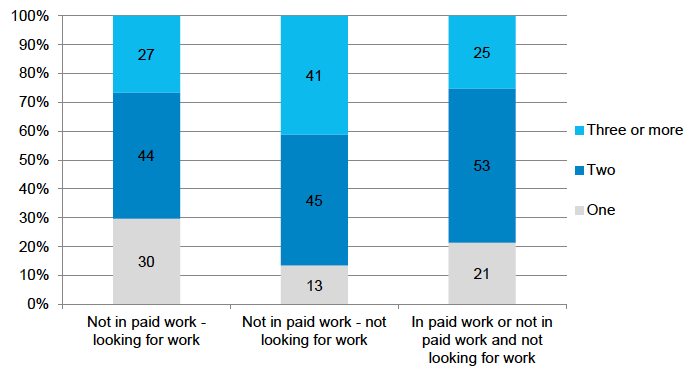
Base: All mothers. Base sizes (unweighted/weighted): Not in paid work - looking for work=173/232; Not in paid work - not looking for work=917/1067; In paid work or not in paid work and not looking for work=4109/4041.
Patterns in the age of the youngest child in the household were similar. At age 3 there were no statistically significant differences between the proportion of mothers looking for work and of other mothers whose youngest child was aged up to 24 months. However, when the cohort child was aged 5, mothers looking for work were less likely to have younger children than other mothers. 27% of those looking for work had a child younger than 3 compared with 40% of other mothers and 50% of those not in paid work and not looking for work (Figure 3-6).
Figure 3‑6: Age of youngest child in household, by mother’s employment and work-seeking status when child aged 5
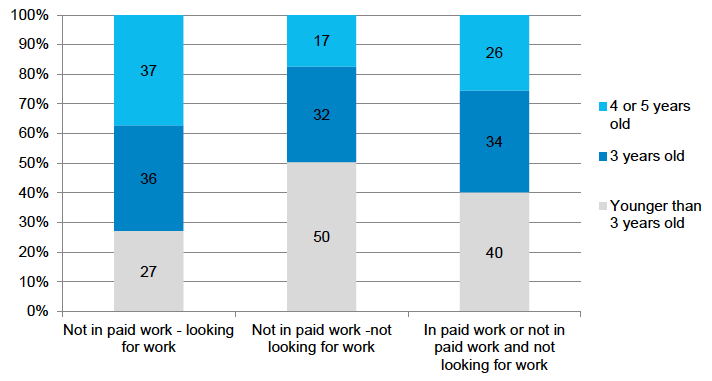
Base: All mothers. Base sizes (unweighted/weighted): Not in paid work - looking for work=173/232; Not in paid work - not looking for work=917/1067; In paid work or not in paid work and not looking for work=4109/4041.
3.5.3 Area characteristics
Compared with other mothers, those looking for work were more likely to live in areas of higher deprivation. When the cohort child was 10 months, 33% of mothers looking for work lived in an area in the most deprived quintile and 11% lived in an area in the least deprived quintile compared with 23% and 18% of other mothers. As the child grew older, mothers looking for work were more likely to be living in the most deprived areas. The proportion living in an area in the most deprived quintile rose from 33% when the child was aged 10 months to 41% when the child was aged 5.
Among mothers who were not in paid work, there were no statistically significant differences between those who were and were not looking for work according to area deprivation.
Mothers who were seeking work were not distinct from other mothers in terms of the urban-rural classification of their local area.
3.5.4 Child and maternal health
Looking at all mothers – including those in paid work – there were no statistically significant differences between mothers who were looking for work and other mothers in terms of the prevalence of maternal long-term health conditions, at any age point. However, among mothers who were not in paid work, those who were and were not looking for work did differ on this measure – though only when the child was aged 3 when 15% of mothers looking for work reported a long-term health condition compared with 24% of those not looking (Figure 3-7). Differences when the child was aged 10 months and 5 years showed a similar pattern but differences at these age points were not statistically significant.
Figure 3‑7: Whether mother had long-term health condition, by mother’s employment and work-seeking status when child aged 3
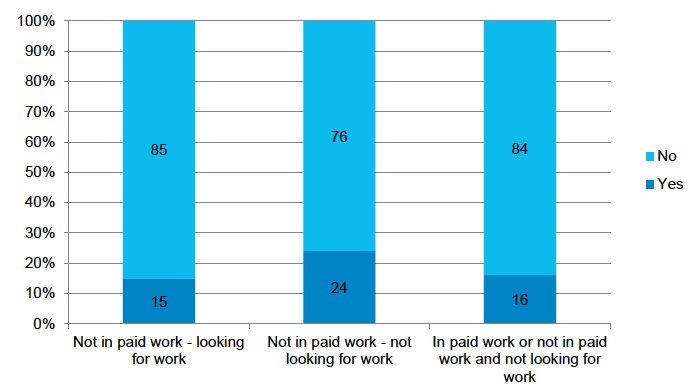
Base: All mothers. Base sizes (unweighted/weighted): Not in paid work - looking for work=211/266; Not in paid work - not looking for work=1231/1380; In paid work or not in paid work and not looking for work=4624/4558.
In terms of whether the cohort child had a long-term health condition or disability, there were no statistically significant differences either between mothers who were looking for work and all other mothers or those out of work but not looking for work.
3.5.5 Multivariable analysis
Logistic regression analysis was used to explore the independent associations between the characteristics described above and looking for work. Two sets of regression models were created. In the first set, the models explored characteristics associated with mothers looking for work compared with mothers who were either in paid work or not in paid work and not looking for work. The second set looked only at mothers who were not in paid work, comparing those who were looking for work with those who were not looking. The two models were run on data from each age point. Only variables which were statistically significant in the bivariate analysis described in the previous sections were included in the regression models [13] .
By far the most consistent independent predictor of work-seeking was maternal age. After controlling for other factors, mothers seeking work were significantly more likely than those in paid work or not in paid work and not seeking work to be younger than 30 when the cohort child was born. This result was found in all models at all age points. Being in the youngest age group – under 20 when the cohort child was born – was particularly strongly associated with looking for work. When contrasted with mothers who were also not in paid work but were not looking for work, the odds of mothers in this age group looking for work when the child was aged 5 were 8 times higher than those for mothers in the oldest age group.
As may be expected, household income was also a strong and consistent predictor of whether or not a mother was looking for work. When comparing mothers who were looking for work with all other mothers, being in a lower income group was independently associated with looking for work at all age points. However, having a lower income was not associated with looking for work when comparing those looking for work with those not looking, when the child was aged 10 months and 5 years.
Some family characteristics also showed statistically significant associations with work-seeking, though not across all models and time points. When the child was aged 3 and 5, after controlling for other factors, single mothers were more likely than those living in couples to be seeking work when comparing those looking for work with all other mothers. For example, at age 3, the odds of single mothers looking for work were 1.5 times higher than those for mothers in couple families. When analysis was restricted to mothers who were out of work only, being a single parent was also associated with looking for work, but only when the child was aged 5. At the same time, the age of the youngest child in the household was independently related to looking for work. For example, among all mothers and when restricted to those who were not in paid work when the child was aged 5, those whose youngest child was 3 or older were more likely than those with a child under 3 to be looking for work. Looking again at mothers who were not in paid work, the number of children in the household was only independently associated with looking for work when the cohort child was aged 10 months, when those with more than one child were less likely to be seeking work than those with two or more children, after controlling for other factors [14] .
The mother having a long-term health condition only emerged as being statistically significant in relation to work-seeking at age 3. Among mothers who were not in paid work, those who reported a long-term health condition had lower odds of seeking work than those without such a condition.
Contact
Email: Ganka Mueller
Phone: 0300 244 4000 – Central Enquiry Unit
The Scottish Government
St Andrew's House
Regent Road
Edinburgh
EH1 3DG
There is a problem
Thanks for your feedback